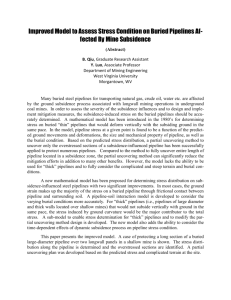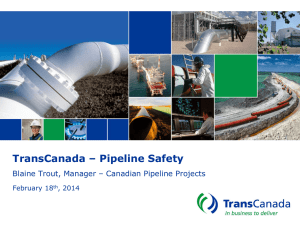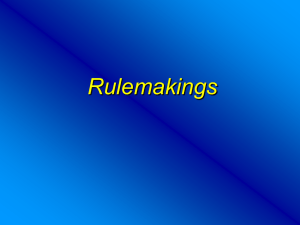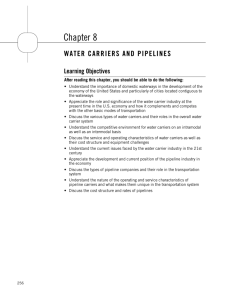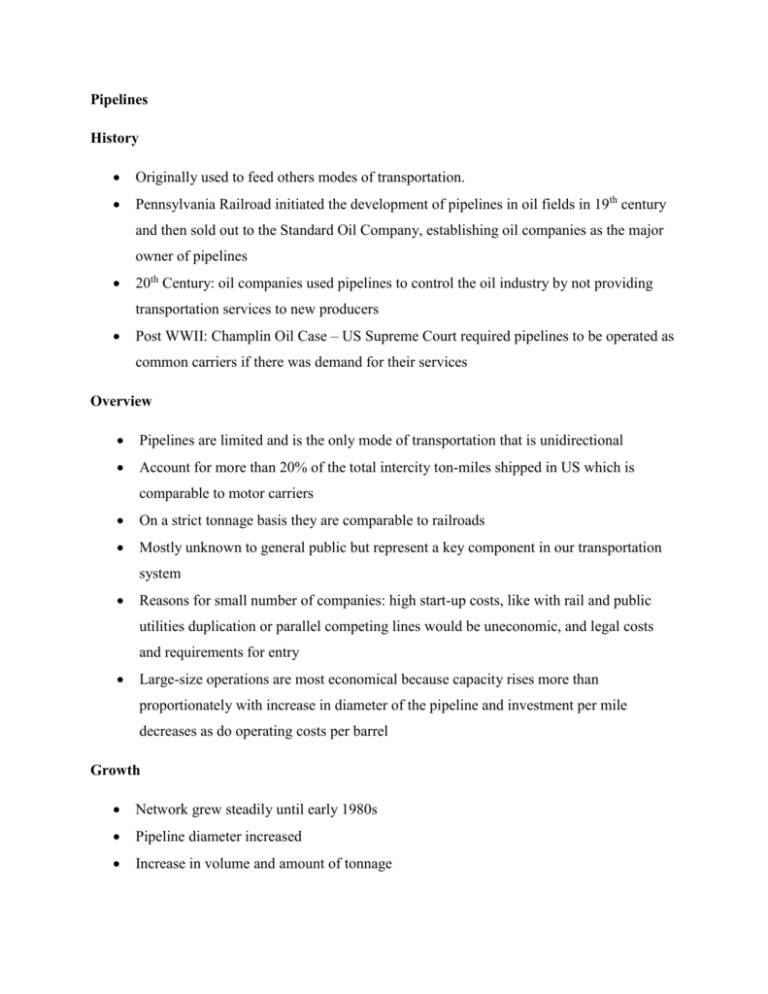
Pipelines
History
Originally used to feed others modes of transportation.
Pennsylvania Railroad initiated the development of pipelines in oil fields in 19th century
and then sold out to the Standard Oil Company, establishing oil companies as the major
owner of pipelines
20th Century: oil companies used pipelines to control the oil industry by not providing
transportation services to new producers
Post WWII: Champlin Oil Case – US Supreme Court required pipelines to be operated as
common carriers if there was demand for their services
Overview
Pipelines are limited and is the only mode of transportation that is unidirectional
Account for more than 20% of the total intercity ton-miles shipped in US which is
comparable to motor carriers
On a strict tonnage basis they are comparable to railroads
Mostly unknown to general public but represent a key component in our transportation
system
Reasons for small number of companies: high start-up costs, like with rail and public
utilities duplication or parallel competing lines would be uneconomic, and legal costs
and requirements for entry
Large-size operations are most economical because capacity rises more than
proportionately with increase in diameter of the pipeline and investment per mile
decreases as do operating costs per barrel
Growth
Network grew steadily until early 1980s
Pipeline diameter increased
Increase in volume and amount of tonnage
Types of Carriers
Champlin Oil Case pipelines operate as common carriers
Some private carriers
Industry is dominated by for-hire carriers
Common carriers = 92% of all pipeline carriers
Competition
Limited intramodal: small number of companies, oligopolistic market structure = limited
price competition, joint ownership, high capital costs
Intermodal
o Most serious competition is water, or tanker, operations. Closest to matching
pipeline costs and rates but water’s limited network limits their ability to compete.
o Trucks complement rather compete because trucks distribute/deliver for pipelines
o Once pipelines have been constructed between 2 points it’s difficult for other
modes to compete because of the low operating costs, dependability, and limited
damage to product being transported
Commodities
Oil: largest commodity transported
Natural Gas
Coal: moved in a ‘slurry’ form or in pulverized form in water until it has reached its
location where the water is then removed. Generally used to transport coal to utility
companies for generating electricity
Chemicals: anhydrous ammonia (fertilizer), propylene (detergents), ethylene (antifreeze)
Advantages
Low rates: average revenues are below one-half of a cent per ton-mile which is indicative
of their low operating cost
Very good loss and damage record
Slow service pipelines can be regarded as functioning as a warehouse
Virtually unaffected by weather conditions
Rarely have mechanical failures
Disadvantages
Slow speed
Fixed route/network, no door-to-door service
Depend on rail and motor carriers to complete delivery
Limited to only a very types of commodities (liquid or gas)
Limited geographic areas and limited areas within that geographic area
Classification
Trunk Lines: used for long-distance movement of crude oil or other products, such as jet
fuel, kerosene, chemicals, or coal
o Two types: crude and product lines
Gathering Lines: used to bring the oil from the fields to storage areas before the oil is
processed into refined products or transmitted as crude oil over the trunk lines to distant
refineries
Diameter
Gathering lines are smaller in diameter not exceeding 8 inches and are laid on the surface
of the ground to make it easier to relocate them when a well or field runs dry
Trunk lines are usually 30-50 inches in diameter are usually permanent and are laid
underground
Power Stations
Stations that provide the power to push the commodities through the pipeline
Interspersed along trunk line
For oil movements, the pumps are located at stations. Station locations vary depending on
the viscosity of the oil and the terrain.
Compressors are used for the movement of natural gas and pumps for the movement of
liquid items
Ownership
Oil companies have been predominate owners of oil pipelines since Standard Oil
Company bought out the Pennsylvania Railroad
Federal government briefly owned during WWII to ensure uninterrupted flow of oil
during the war
o Big Inch and Little Inch
o Sold to private companies after the war
Joint Ventures: some pipelines are operated as joint ventures because of the capital
investment need for large-diameter pipelines
Oil companies – 46%
Joint ventures – 27%
Railroads, independent oil companies, and other companies account for the remaining
percentage
Preventative Maintenance
Is essential in limiting loss and damage and protecting the environment
Protective paints and resins are used for corrosion control
Electric currents are used to neutralize the corroding electrical forces that come naturally
from the ground to the pipeline
Pipeline’s have a record of limited loss and damage due to the industry’s approach to
operations. The pipes are constructed using a high-quality alloy steel with a life
expectancy of 50 years or more. The pipes are laid in long sections with a limited
number of seams and high quality electronic welding of seams prevents leakage.
Batching
When 2 or more grades of crude oil or 2 or more products move through a system at one
time, the batches my need to be separated.
There are 15 grades of crude oil with a range of products including jet fuel, types of
gasoline (regular, unleaded, and premium), diesel fuel, heating oil, kerosene, and aviation
fuel.
The batches are separated using a rubber ball called a batching pig. This technique is not
always necessary because the specific grades of the products can keep them separated.
When mixed, a higher grade item will be considered as part of the lowest grade product it
is mixed with.
Cost Structure
Much like the railroad industry, high proportion of fixed cost with low capital
turnover
Fixed: Owners have to provide their own right-of-way by purchasing or leasing land
and constructing the pipeline and stations along the way (property taxes, amortization
or depreciation, and preventative maintenance). Terminal facilities require
depreciation and property taxes
Low variable costs because the ‘vehicle’ required is the pipe itself. Unlike other
forms of transportation, pipelines do not require vehicles to move commodities and
therefore have a low variable cost. Estimated to only account for 30-40% of total cost
in the pipeline industry.
Labor costs are relatively low because of the use of automation. Example: TransAlaska Pipeline System – built at a cost of $9.2 billion and is operated by 450
employees
Rates: Pipelines quote rates on a pre-barrel basis (one barrel = 42 gallons). Quotes are typically
point to point or zone to zone and a minimum shipment size is usually required.
Issues
Safety: environmental impact and limiting leakage
o Mostly built in rural areas but when house needs increase people may be living
closer to the pipelines and special attention will be needed.
o Wildlife
The Office of Pipeline Safety
Part of U.S. DOT
Establishes and monitors pipeline activities as they relate leakage from oil pipelines.
Each carrier develops oil spill response plans for onshore pipelines.
Federal Energy Regulatory Commission
FERC
Purpose
Responsibilities
Natural Gas Pipelines
Underground
Movement by compressors
The Alaska Pipeline
Begun after oil was discovered on the North Slope of Alaska in 1968.
$8 billion to construct can handle up to 2 million barrels of oil per day.
800 miles long and completed in 1977.
½ inch thick steel, 48 inch diameter pipe, 4 inches of fiberglass insulation
10 pump stations, flows at 5 to 7 mph, 8 days to travel 800 miles from Arctic Ocean to
Valdez where it’s transferred to oil tankers.
Temperature
o Oil is pumped from depths of several thousand feet at 160 to 180ºF
o Heat exchangers cool oil to 120ºF when it enters the pipeline
o At 120ºF the pipe would be hot enough to melt the permafrost. To prevent
melting, the pipeline was constructed above ground (about 400 miles)
o Insulation keeps the temperature of oil nearly constant.
Federal Energy Regulatory Commission (FERC)
Operate under The Interstate Commerce Act and regulates the rates and practices of oil
pipeline companies engaged in interstate transportation.
Establish “just and reasonable” rates to encourage maximum use of oil pipelines
Prevent discrimination by ensuring shippers equal access to pipeline transportation, equal
service conditions on a pipeline, and reasonable rates for moving petroleum and
petroleum products by pipeline.
Slurry: A solid is broken up and suspended in a liquid, can be moved through a pipeline
Keystone XL Pipeline Project
Originally proposed by TransCanada
1,897 km (1,179 mile) from Canada boarder to connect to an existing pipeline in Steele
City, Nebraska
Expected to provide 5% of US petroleum consumption needs and represent 9% of US
petroleum imports
Volume of Keystone XL is equal to a train 25 miles long transporting everyday
For every pipeline incident there are 50 railway accidents
Required capacity to meet demands is 1.1 million barrels per day
An import line to US refineries
Will create about 20,000 construction and manufacturing jobs
Generate more than $585 million in new taxes for states and communities along pipeline
route
Strengthen America’s energy security by increasing supply of safe, secure, and reliable
oil from Canada and American oil fields
Kentucky’s Pipelines
2 million miles in US
o 25, 394 miles in Kentucky
861 miles for hazardous liquids
o Gasoline
o Diesel
o Jet fuel
Sources
Coyle, John Joseph, Edward J. Bardi, and Robert A. Novack."Pipelines."Transportation. 4th ed.
St. Paul/Minneapolis: West Pub., 1994. 241-255. Print.
"Freight Modes in Kentucky." Kentucky Transportation Cabinet, Apr. 2011. Web. 26 Apr. 2012.
<http://transportation.ky.gov/Planning/Documents/Freight%20Modes%20in%20Kentucky.pdf>.
Fricker, Jon D., and Robert K. Whitford."Oil and Gas Pipelines."Fundamentals of
Transportation Engineering: A Multimodal Approach. Upper Saddle River, NJ: Pearson Prentice
Hall, 2004. 672-74. Print.
"Kentucky Transportation Cabinet - KYTC." Web. 26 Apr. 2012.
<http://transportation.ky.gov/Pages/default.aspx>.
"Keystonepipelinexl."Keystonepipelinexl.U.S. Department of State, n.d. Web. 19 June 2012.
<http://www.keystonepipeline-xl.state.gov/>.
"Keystone XL Pipeline Project."Keystone XL Pipeline Project. TransCanada, 9 May 2012. Web.
19 June 2012. <http://www.transcanada.com/keystone.html>.
"TransCanada's Keystone XL Pipeline Know the Facts." TransCanada, June 2021. Web. 19 June
2012. <http://www.transcanada.com/docs/Key_Projects/know_the_facts_kxl.pdf>.

